The Best Patient Engagement Solutions in New Jersey

Effective patient engagement is the foundation of modern healthcare, vital for improving outcomes, enhancing satisfaction, and supporting adherence to treatment plans. When executed well, engagement reduces hospital readmissions, improves management of chronic conditions, and empowers patients and providers alike.
Healthcare leaders across New Jersey must embrace digital strategies for engaging patients. From the urban sprawl of Newark to the coastal towns of the Garden State, healthcare providers face unique demands shaped by a mix of seniors, working families, and diverse immigrant communities.
Fortunately, scalable, cloud-based tools now exist to help healthcare teams in the Garden State overcome these challenges efficiently and proactively.
The Patient Engagement Challenge
Across New York, healthcare providers face multiple obstacles as they strive to deliver high-quality, timely, and personalized care:
Siloed systems and disconnected platforms often result in incomplete medical records. This gap in continuity makes it difficult for physicians and care coordinators to access the accurate, real-time data they need to deliver thorough, individualized treatment.
Solution:
Unified Patient Profiles
- Bring together EHRs, wearable data, patient surveys, and clinical records.
- Allow providers to review historical and social context data.
- Promote shared access for collaborative care within and across facilities.
Traditional methods like phone calls or mailed reminders are often ineffective for reaching modern, digitally oriented patients especially in diverse urban environments like Jersey City, Trenton, or Paterson.
Solution:
Streamlined Communication
- Integrate data from electronic health records (EHRs), patient surveys, and wearable devices.
- Adapt outreach to match each patient’s preferred method and language.
- Enable real-time two-way messaging for convenience and responsiveness.
Manual scheduling, administrative bottlenecks, and underutilized technology lead to extended wait times, overburdened staff, and slower service delivery.
Solution:
Automated Workflows
Meeting HIPAA standards while also providing smooth digital interactions is a fine balance, particularly as patient expectations grow around data privacy and access.
Solution:
Secure Data Management
Healthcare providers frequently deal with fragmented patient records due to incompatible data systems, resulting in incomplete patient histories and compromised care quality.
Solution:
Comprehensive Patient Profiles
- Use unified patient portals to communicate care plans and updates.
- Reach out proactively with multi-touch, automated communication.
- Monitor trends, identify vulnerable patients, and intervene early.
-
Fragmented Patient Data
-
Communication Gaps
-
Operational Inefficiencies
-
Regulatory Compliance
-
Limited Access / Fragmented Care
Siloed systems and disconnected platforms often result in incomplete medical records. This gap in continuity makes it difficult for physicians and care coordinators to access the accurate, real-time data they need to deliver thorough, individualized treatment.
Solution: Unified Patient Profiles
- Achieve a 360-degree view of each patient to enable more precise care planning.
-
- Bring together EHRs, wearable data, patient surveys, and clinical records.
- Allow providers to review historical and social context data.
- Promote shared access for collaborative care within and across facilities.
Traditional methods like phone calls or mailed reminders are often ineffective for reaching modern, digitally oriented patients—especially in diverse urban environments like Jersey City, Trenton, or Paterson.
Solution: Streamlined Communication
- Use multi-channel outreach to improve appointment attendance and follow-through.
-
- Employ text messages, secure emails, and in-app notifications.
- Adapt outreach to match each patient’s preferred method and language.
- Enable real-time two-way messaging for convenience and responsiveness.
Manual scheduling, administrative bottlenecks, and underutilized technology lead to extended wait times, overburdened staff, and slower service delivery.
Solution: Automated Workflows
- Leverage AI and automation to streamline clinical and administrative tasks.
-
- Automate appointment bookings, check-ins, and follow-up notifications.
- Use triage tools to classify urgency and delegate care accordingly.
- Forecast patient volume and plan staffing with predictive analytics.
Meeting HIPAA standards while also providing smooth digital interactions is a fine balance, particularly as patient expectations grow around data privacy and access.
Solution: Secure Data Management
- Maintain compliance and protect sensitive patient data with robust infrastructure.
-
- Implement strict role-based access controls and audit trails.
- Encrypt all transmissions and continuously monitor for threats.
- Ensure accountability and transparency with full system logs.
Solution: Population Health Management
- Enable better outcomes and cost-efficiency across New Jersey’s varied populations.
-
- Use unified patient portals to communicate care plans and updates.
- Reach out proactively with multi-touch, automated communication.
- Monitor trends, identify vulnerable patients, and intervene early.
VALiNTRY360’s Patient Engagement Solutions
Harness the power of digital, cloud-based technology to create a seamless, unified patient engagement platform:
-
Patient Management
-
Telehealth Integration
-
Appointment Management
-
Billing and Payment Management
-
Real-Time Insights
- Monitor complete patient history, including medical records, appointments, and past interactions.
- Deliver personalized care recommendations based on each patient’s unique profile and risk factors.
- Implement care plans with automated task delegation and real-time progress tracking.

- Integrate video conferencing for virtual consultations, removing barriers to accessing care.
- Utilize remote patient monitoring to track vital signs and symptoms in real time.
- Facilitate secure messaging between patients and care teams to provide continuous support.

- Simplify scheduling with intelligent calendar management and optimized resource allocation.
- Minimize no-shows with automated reminders and convenient rescheduling options.
- Use waitlist management to efficiently fill last-minute cancellations.

- Streamline financial operations with automated billing systems.
- Offer clear cost estimates and flexible payment solutions for patients.
- Seamlessly integrate insurance verification and claims processing to enhance the financial experience.

- Leverage predictive modeling to identify at-risk patients for timely interventions.
- Optimize resource distribution based on patient needs and past usage patterns.
- Monitor and enhance key metrics like patient satisfaction, readmission rates, and adherence to care plans.
- Create custom reports and dashboards for real-time, data-driven decision-making across the organization.

- Monitor complete patient history, including medical records, appointments, and past interactions.
- Deliver personalized care recommendations based on each patient’s unique profile and risk factors.
- Implement care plans with automated task delegation and real-time progress tracking.

- Integrate video conferencing for virtual consultations, removing barriers to accessing care.
- Utilize remote patient monitoring to track vital signs and symptoms in real time.
- Facilitate secure messaging between patients and care teams to provide continuous support.

- Simplify scheduling with intelligent calendar management and optimized resource allocation.
- Minimize no-shows with automated reminders and convenient rescheduling options.
- Use waitlist management to efficiently fill last-minute cancellations.

- Streamline financial operations with automated billing systems.
- Offer clear cost estimates and flexible payment solutions for patients.
- Seamlessly integrate insurance verification and claims processing to enhance the financial experience.

- Leverage predictive modeling to identify at-risk patients for timely interventions.
- Optimize resource distribution based on patient needs and past usage patterns.
- Monitor and enhance key metrics like patient satisfaction, readmission rates, and adherence to care plans.
- Create custom reports and dashboards for real-time, data-driven decision-making across the organization.

What You Can Expect with VALiNTRY360’s Patient Engagement Solutions


Why Choose VALiNTRY360’s Patient Engagement Experts?
Our experience spans hospitals, clinics, and specialty practices across the U.S.—with strategies tailored to meet the particular demands of healthcare in New Jersey.
Our solutions consistently lead to increased patient engagement, improved clinical outcomes, and smoother day-to-day operations for care teams.
We don’t believe in one-size-fits-all. Every platform is tailored to meet the specific needs, goals, and constraints of your healthcare environment.
Ready to Upgrade Your Patient Engagement?
Whether you’re in Phoenix or Flagstaff, outdated systems shouldn’t slow you down. VALiNTRY360’s digital solutions empower you to:
Increase patient
satisfaction
Elevate health
outcomes
Maximize operational efficiency
Ensure regulatory compliance
Drive financial
growth
Reach out to VALiNTRY360 today for a free consultation and take the first step toward transforming your patient engagement strategy, delivering exceptional care experiences across the Grand Canyon State.
The Best Patient Engagement Solutions in New York FAQ By 
Patient engagement is the process of actively involving patients in their healthcare decisions, encouraging them to take part in their treatment plans.
Engaged patients experience better health outcomes, higher satisfaction, improved treatment adherence, and reduced overall healthcare costs.
Key challenges include fragmented patient data, communication barriers, inefficiencies in operations, and compliance with regulatory requirements.
Digital solutions help by creating unified patient profiles, simplifying communication, automating tasks, and ensuring secure management of patient data.
Population health management takes a proactive approach to improving health outcomes for groups of people, often targeting specific regions or patient demographics.
Implementing a PHM strategy leads to improved health outcomes, lower healthcare costs, enhanced care coordination, and more efficient resource management.
Data analytics help identify high-risk patients, forecast potential health issues, and provide valuable insights for targeted interventions and optimized resource allocation.
Social determinants of health refer to non-medical factors like housing, education, and income that affect health outcomes. They are key in PHM for addressing underlying causes of health disparities.
Telehealth supports virtual consultations, remote monitoring, and secure messaging, improving access to care and offering continuous support for patients.
Social determinants of health refer to non-medical factors like housing, education, and income that affect health outcomes. They are key in PHM for addressing underlying causes of health disparities.
Telehealth supports virtual consultations, remote monitoring, and secure messaging, improving access to care and offering continuous support for patients.
VALiNTRY360 provides solutions for patient management, telehealth integration, appointment management, and billing to enhance patient engagement and improve overall care experiences.
Providers can leverage secure platforms that offer role-based access controls and create comprehensive audit trails for tracking all data access and modifications.
Success can be gauged by monitoring key metrics like patient satisfaction scores, appointment attendance rates, treatment compliance, and improvements in overall health outcomes.
AI supports predictive analytics, automates patient communication, streamlines triage processes, and offers personalized care recommendations based on patient data.
Chronic disease management focuses on continuous engagement and support for self-management, while acute care emphasizes short-term treatment adherence and timely follow-up.
Approaches include simplifying technology interfaces, offering multiple communication channels, involving family members, and providing in-person support when necessary.
By utilizing data-driven insights, providers can automate routine tasks while customizing meaningful interactions based on each patient’s unique needs and preferences.
Failing to implement effective population health management can lead to greater health disparities, escalating healthcare costs, suboptimal patient outcomes, and missed opportunities for preventive care and early detection.
Patient portals offer convenient access to medical records, appointment scheduling, secure messaging with providers, and tools to help manage care plans and medications effectively.
Providers can boost adoption by offering hands-on training and support, showcasing the advantages of digital tools, ensuring user-friendly design, and seamlessly integrating them into routine healthcare practices.


